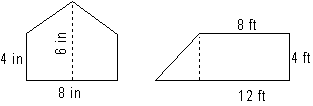Lesson Plan # 6 - Triangles and Composite shapes
with triangles
- (5 min) Mental Math
- Start with 50, subtract 35, then divide by 3 [5]
- What is 1/2 of 6 X 3? [9]
- What is the area of a rectangle whose base is 8 feet and whose height
is 7 feet? [56 sq. ft.]
- Add 8.2 and 2.8 [11]
- What is the perimeter of a rectangle that is 5 cm by 4 cm? [18 cm]
- (5 min) Review of selected problems from Homework # 5 (<= 3
problems)
- (10 min) Introduce the area of a triangle:
- Cut up a rectangle into 2 triangles. Discuss base and height.
Class interaction:
Before class, cut up the triangle cutout sheet into rectangles. Hand
out the rectangles (1 or 2 per student) along with scissors. Have students
first find the area of the rectangle, then cut along the dotted line and
tell you the area of each of the triangles they create. Go around the room
asking for triangle areas
- Introduce the area formula:
B X H Use the letters "A" for area,
A = ------- "B" for base, and "H" for height.
2 (This will help later in algebra)
- Use the above formula for whole number or decimal measurements. Later
we will introduce the familiar A = 1/2 x B x H formula for fractional or
mixed number dimensions.
- Use these examples on the board to illustrate different
triangles:

- (15 min) In-class Exercise - Part 1.
- (5 min) Discuss composite shapes containing triangles.
Use these examples:

Class interaction:
Ask students:
- Where to draw the dotted lines separating the triangles from the rest
of the shape.
- What the base and the height of each triangle is.
- Area of the triangle, and finally,
- Total area of the figure.
- (Remainder of class) In-class Exercise - Part 2.
- Hand out homework as students successfully complete the in-class
exercise.
Note:
It is important to get students to draw the line(s) separating
the triangles from the rest of the figure. It also helps to have them
write
the little "number in the circle" indicating the identity of
each shape, so they can be sure they have added it's area to
the total.
|